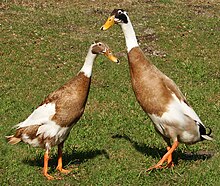Introduction Runner Ducks
Runner ducks are a delightful addition to any backyard or homestead, known for their unique upright posture and friendly demeanor. Unlike traditional ducks, runner ducks are excellent foragers and can help control pests in your garden while providing you with fresh eggs. However, caring for runner ducks requires knowledge and commitment. This complete guide will cover everything you need to know about their care, from housing and feeding to health and socialization.
Understanding Runner Ducks
Before diving into care specifics, it’s essential to understand what makes runner ducks unique. Originating from Southeast Asia, these ducks were bred for their ability to run rather than fly. They come in various colors and patterns, including Indian Runner, Khaki Campbell, and more. Their upright stance and playful nature make them a favorite among duck enthusiasts. Understanding their behavior and needs is crucial for providing the best care.
Housing Requirements
Shelter
Providing a safe and comfortable shelter is vital for your runner ducks. A well-ventilated duck house should protect them from harsh weather conditions and predators. The shelter should be spacious enough to allow them to move freely, with at least 4 square feet per duck. Ensure that the house is insulated and has proper drainage to keep it dry.
Outdoor Space
Runner ducks love to roam and forage. A secure outdoor space is essential for their physical and mental well-being. A fenced area that allows them to explore while keeping them safe from predators is ideal. The enclosure should be at least 10 square feet per duck, with plenty of room for them to run and play. Adding plants, shrubs, and other natural elements can enhance their environment and provide shade.
Feeding Your Runner Ducks
Nutritional Needs
Feeding runner ducks a balanced diet is crucial for their health and egg production. A high-quality commercial duck feed formulated for layers is recommended, as it contains the necessary nutrients, vitamins, and minerals. Ensure that the feed is specifically designed for ducks, as their dietary needs differ from chickens.
Supplementing Their Diet
In addition to commercial feed, runner ducks enjoy foraging for insects, worms, and plants. Allowing them to roam in a safe area will enable them to supplement their diet naturally. You can also provide kitchen scraps, such as fruits and vegetables, but avoid feeding them anything toxic, like onions, chocolate, or avocados. Fresh water should always be available, as ducks require it for digestion and to keep their feathers in good condition.
Water Needs
Access to Water
Ducks are waterfowl, and access to water is essential for their health. Unlike chickens, ducks need water deep enough to submerge their heads, as this helps them clean their nostrils and eyes. A kiddie pool or a large water trough can serve this purpose. Ensure that the water is clean and changed regularly to prevent the spread of disease.
Bathing and Swimming
Allowing your runner ducks to swim and bathe is crucial for their well-being. Swimming helps them maintain their feathers and provides exercise. However, ensure that the water is shallow enough to prevent drowning, especially for younger ducks. Supervise their swimming sessions to ensure they are safe and comfortable.
Health Care for Runner Ducks
Regular Health Checks
Routine health checks are essential for maintaining the well-being of your runner ducks. Look for signs of illness, such as lethargy, loss of appetite, or abnormal droppings. Regularly check their eyes, beaks, and feet for any signs of injury or infection. Keeping a close eye on their behavior will help you catch any potential health issues early.
Vaccinations and Preventative Care
Consult with a veterinarian experienced in avian care to determine the necessary vaccinations for your runner ducks. Common vaccinations include those for avian influenza and Newcastle disease. Additionally, consider implementing a parasite control program to prevent infestations of worms, mites, and lice. Regularly clean their living area to minimize the risk of disease.
Socialization and Behavior
Understanding Duck Behavior
Runner ducks are social animals and thrive in groups. Keeping at least two ducks together is essential to prevent loneliness and stress. They communicate through various vocalizations, and understanding their body language can help you gauge their mood and well-being.
Interaction with Humans
Spending time with your runner ducks will help them become more comfortable around humans. Regular handling and interaction will make them friendlier and easier to manage. Offer treats and engage in gentle play to build trust and strengthen your bond with them.
Breeding Runner Ducks
Breeding Considerations
If you’re interested in breeding runner ducks, it’s essential to understand the basics of duck reproduction. Ensure that you have a healthy male-to-female ratio, typically one male for every three females. This ratio helps reduce stress and competition among the ducks.
Nesting and Egg Laying
Runner ducks typically start laying eggs at around 5 to 6 months of age. Provide nesting boxes filled with straw or hay to encourage them to lay





